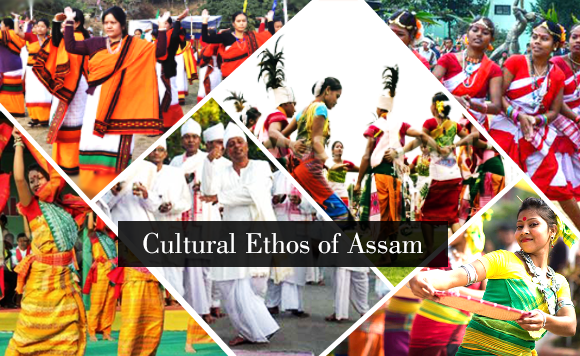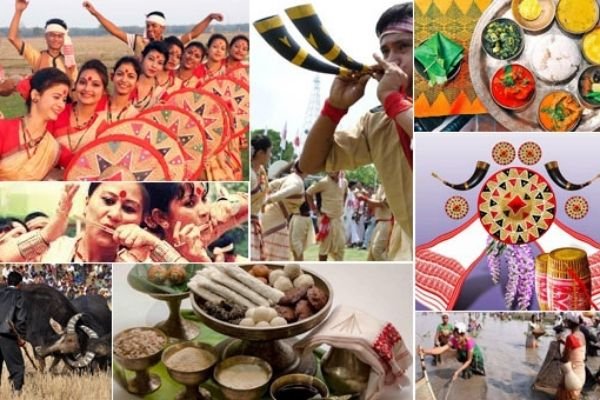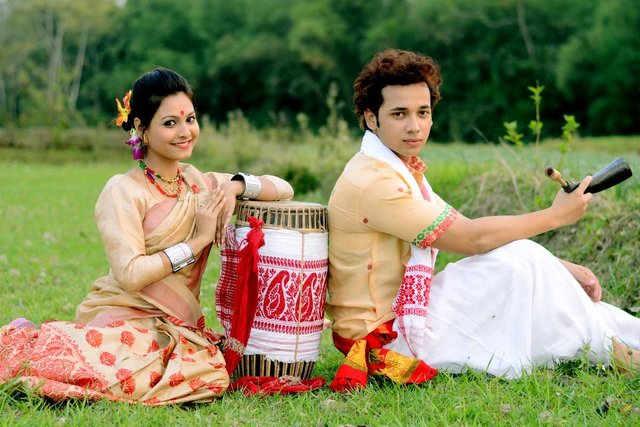

Introduction:
Nestled in the northeastern corner of India, Assam is a land of unparalleled beauty and cultural diversity. With its lush green landscapes, meandering rivers, and vibrant traditions, Assam has captured the imaginations of travelers and scholars alike. In this article, we will embark on a journey through the cultural heritage of Assam, delving into its music, dance, cuisine, festivals, and more.
Music and Dance:
Assam's cultural landscape is deeply intertwined with its music and dance forms. Bihu, the most celebrated festival in Assam, is marked by the energetic Bihu dance and melodious Bihu songs. The soulful strains of the Borgeet, a classical music form created by the revered Sankardeva, continue to resonate through the ages. Additionally, the Oja-Pali and Sattriya dance traditions showcase the state's devotion and artistic expression.
Cuisine:
Assamese cuisine is a delightful fusion of flavors, reflecting the state's agricultural abundance. Rice is the staple, and a traditional meal often includes fish, meat, and an array of leafy greens and herbs. Assam is famous for its bamboo shoot and Bhut Jolokia, one of the world's spiciest chili peppers. Unique dishes like Assam Laksa, Masor Tenga (sour fish curry), and Assam Tea are a testament to the state's culinary richness.
Silk and Textiles:
Assam is renowned for its exquisite silk, particularly Muga silk and Eri silk. Muga silk is exclusive to the state and is known for its golden sheen. The traditional attire, Mekhela Chador for women and Gamosa for men, are made from these splendid silks and are an integral part of Assamese culture.
Festivals:
Assam's calendar is marked by a plethora of festivals, each offering a unique glimpse into its cultural mosaic. Apart from Bihu, festivals like Durga Puja, Magh Bihu, and Ambubachi Mela are celebrated with great fervor. These festivals showcase a harmonious blend of Hindu and indigenous traditions.
Language and Literature:
The Assamese language, with its rich literary heritage, plays a pivotal role in the state's culture. Assamese literature has a long history, with luminaries like Srimanta Sankardeva and Laxminath Bezbaroa contributing significantly to its growth. The Jyoti Chitraban Film Studio in Assam has also made significant contributions to Indian cinema.
Handicrafts and Traditions:
Assam boasts a vibrant tradition of handicrafts, including intricate bamboo and cane work, pottery, and mask making. The Bodo and Mising communities, in particular, are known for their unique craft traditions. Additionally, the state's unique Bhaona performances, depicting mythological tales, are an integral part of Assamese culture.
Conclusion:
Assam's cultural tapestry is a colorful mosaic, blending tradition and modernity, diversity and unity. It is a place where the rhythms of Bihu dances echo through the tea gardens, where the aroma of Assam tea fills the air, and where the warmth of Assamese hospitality makes every visitor feel at home. Exploring Assam's rich cultural heritage is a journey that unveils a world of beauty, tradition, and vibrant life waiting to be discovered.

Bihu Festival: The Heartbeat of Assam's Cultural Rhythm
Introduction:
Nestled in the lush green landscapes of Assam, the Bihu festival stands as a vibrant testament to the state's rich cultural heritage. Celebrated with fervor and enthusiasm, Bihu is more than just a festival; it's a reflection of Assam's agricultural roots, its lively traditions, and the spirit of unity that binds its people. In this article, we will explore the essence of Bihu and its significance in Assam's culture.
Bihu: The Trio of Festivals:
Bihu is not a single festival but a trio of celebrations, each corresponding to a distinct phase of Assam's agricultural calendar. Rongali Bihu in April marks the Assamese New Year and the onset of the sowing season. Kati Bihu in October observes the time when the crops are in the field, and Magh Bihu in January signifies the harvest festival.
Traditional Bihu Dance:
The heart of Bihu celebrations lies in the lively and energetic Bihu dance. Dancers, adorned in traditional attire, perform intricate steps to the beats of the dhol (drum), pepa (buffalo horn pipe), and gogona (a reed-and-bamboo instrument). The dance is not just a cultural expression but also an essential part of farming rituals, where it's believed to invoke a good harvest.
Bihu Songs:
Bihu songs, known as Bihu Geet, are an integral part of the festivities. These songs, often accompanied by the vibrant sounds of the pepa and gogona, narrate tales of love, nature, and everyday life in Assam. The melodious tunes and poetic lyrics captivate both locals and visitors alike.
Traditional Attire:
During Bihu, Assamese men and women don traditional attire that adds a colorful touch to the celebrations. Women wear the Mekhela Chador, a two-piece ensemble with intricate designs, while men don the traditional dhoti and gamosa. The vibrant colors and designs of these outfits reflect the festive spirit.
Feasting and Culinary Delights:
No Bihu celebration is complete without a sumptuous feast. Assamese cuisine takes center stage during this time, featuring dishes like Masor Tenga (sour fish curry), various chutneys, pithas (rice cakes), and sweets like til pitha and laru. The use of indigenous ingredients and flavors adds a distinct taste to the celebrations.
Community Bonding:
Bihu transcends generational and cultural boundaries, fostering a sense of unity among the people of Assam. It's a time when families come together, neighbors share their harvests, and communities strengthen their bonds through music, dance, and merriment.
Conclusion:
Bihu, with its rhythmic dances, melodious songs, and traditional rituals, is the lifeblood of Assam's culture. It encapsulates the spirit of Assamese life, deeply rooted in agriculture and community. The festival not only celebrates the changing seasons but also the enduring traditions that have sustained the people of Assam for generations. To experience Bihu is to immerse oneself in the heart and soul of Assam's vibrant cultural rhythm.